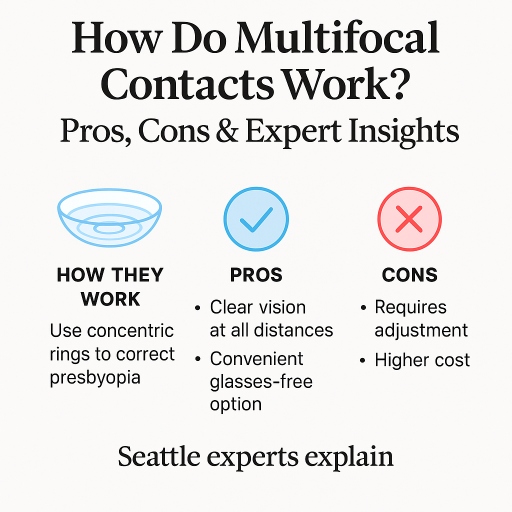Multifocal Contacts: Clear Vision at Every Distance
Over 40 and tired of readers? Multifocal contacts offer clear vision at all distances—learn how they work, their pros/cons, and if they’re your solution. Seattle experts explain.
How Do Multifocal Contacts Work? Pros, Cons & Expert Insights
If you’re over 40 and struggling to read your smartphone or computer screen, you’re not alone. Presbyopia—the age-related loss of near vision—drives many long-time contact lens wearers to abandon their contacts for reading glasses. But modern multifocal contact lenses now offer a seamless solution, providing clear vision for up-close tasks, intermediate distances (like computer screens), and faraway objects—all in one lens.
Why Multifocal Contacts Are a Game-Changer for Over-40 Vision
Living in tech-centric cities like Seattle, where screen time is unavoidable, intermediate vision is critical. Multifocal contacts eliminate the need to juggle reading glasses for tasks like scrolling your phone, working on a laptop, or even recognizing a friend across a café table.
Key Benefits:
- All-in-one clarity: See near, far, and intermediate distances without switching glasses.
- Ideal for digital lifestyles: Perfect for computer work, driving, and everyday activities.
- Natural transition: Unlike monovision contacts (one lens for distance, one for near), multifocals mimic natural eye focus.
Important Considerations Before Choosing Multifocal Contacts
While multifocal lenses can revolutionize vision for patients in their 40s and beyond, they aren’t perfect for everyone. As an optometrist, I emphasize that proper fitting is crucial. Expect more follow-up visits and higher fitting fees compared to standard lenses. Patients with astigmatism may need specialized (and pricier) multifocal toric lenses, and some may still require occasional readers.
The 80% Rule for Multifocal Contact Lenses: Setting Realistic Expectations
When fitting patients with multifocal contact lenses, I always explain the 80% Rule—a guiding principle for success. If you demand flawless vision, multifocals might not be for you. But if you want a functional, glasses-free vision for most daily tasks, these lenses can be transformative.
What Is the 80% Rule?
- Success = 80% satisfaction: If you’re happy with your vision 80% of the time without needing readers, the fit works.
- Embrace compromise: Modern multifocal lenses like Air Optix Multifocal and Biofinity Multifocal are light years ahead of older designs, but minor quirks like slight “ghosting” (a faint shadow around the text) may persist.
- Daily disposable advancements: Newer options like Dailies Total1 Multifocal and MyDay Multifocal offer sharper vision and comfort, making this the best era yet for presbyopia correction.
What to Expect from Multifocal Lenses
At Cannon EyeCare in Seattle, most patients achieve 20/20 distance vision and near-perfect close-up clarity with multifocals. One patient shared, “I read street signs as quickly as anyone in the car—even with a tiny bit of fuzziness.” Others describe minor ghosting but rave about ditching readers for work, driving, and daily life.
Why the 80% Rule Works
If multifocals deliver 85-90% satisfaction, it’s a home run. As one thrilled patient said, “I only grab readers once a week now!” But remember: these lenses thrive on realistic expectations. Perfectionists, beware; pragmatists, rejoice!
Pro Tip: Partner with a clinic specializing in multifocal fittings (like ours in Seattle!) to maximize your 80% success.
Choosing the Right Multifocal Lenses: Daily vs. Monthly
Multifocal contact lenses come in two practical formats: daily disposable and monthly replacement.
Your lifestyle and budget will determine the best fit:
-
Daily Disposable Multifocals(e.g., Dailies Total1, MyDay):
- Ideal for part-time wearers or those new to contacts.
- No cleaning or maintenance—perfect for travel or occasional use.
- Cost note: Wearing dailies year-round adds up (~730 lenses annually).
-
Monthly Multifocal Lenses(e.g., Air Optix, Biofinity):
- Better for full-time wearers(5+ days/week).
- More cost-effective long term.
- Require proper cleaning and storage.
Multifocal Contacts vs. Bifocal Contacts: What’s the Difference?
Let’s simplify the multifocal vs. bifocal debate—starting with the basics:
Bifocal Contacts: The “Two-Zone” Approach
- “Bi” means two: Just like a bicycle has two wheels, bifocal lenses have two distinct vision zones:
- Distance vision(top portion).
- Near vision(bottom segment focused at 16”/40cm).
- The catch: Bifocals lack intermediate vision support (e.g., computer screens) and have a visible line separating the zones, similar to old-school “grandpa glasses.”
Why Multifocal Contacts Dominate Modern Care
- Seamless transitions: Multifocal (progressive) lenses use gradual power changes to cover all distances—road signs, laptops, and smartphones—without visible lines.
- Built for modern life: Perfect for screen-heavy routines, driving, and social settings where intermediate vision matters.
- Aesthetic edge: No distracting lines mean they look like regular contacts or glasses.
If you’re upgrading from bifocal glasses, multifocal contacts will feel like a giant leap forward—no clunky transitions, just smooth, all-day clarity.
Modern Multifocal Contacts vs. Bifocals: Why They’re Worlds Apart
Let’s clear up a common myth: multifocal soft contact lenses are NOT bifocals. Unlike their two-zone predecessors, multifocals use advanced optical engineering to mimic your eyes’ natural focus process.
The “Stone in a Pond” Design
Imagine tossing a pebble into calm water—the ripples form concentric rings radiating outward. Modern multifocal lenses work similarly:
- Center-first focus: Near vision is prioritized at the center of the lens, aligning with your pupil when reading (since pupils constrict for close tasks).
- Distance at the edges: As the rings expand outward, the power shifts to distance vision. This mirrors how pupils dilate when looking far away.
How Multifocal Contacts Work with Your Eyes
- Dynamic adaptation: The lens design responds to pupil size changes, ensuring smooth transitions between:
- Reading text (center power).
- Checking your computer (intermediate zones).
- Driving or watching TV (outer rings).
- No jarring jumps: Unlike bifocals, there’s no visible line or abrupt shift between zones—just natural, blended vision.
Why This Matters for You
- Natural vision restoration: Multifocals replicate how young, healthy eyes focus—no clunky “zones” or head-tilting.
- Precision engineering: Brands like Acuvue and Alcon use this concentric ring design to maximize clarity at all distances.
Are Multifocal Contact Lenses Worth It? Cost, Alternatives & Expert Advice
Deciding whether multifocal contacts are worth the investment? Let’s break down the costs, benefits, and affordable alternatives to help you choose.
Multifocal Contacts: Cost vs. Freedom
As of January 2023, multifocal lenses cost 30-66% more than single-vision options. For example:
- Air Optix Multifocal: ~66% pricier annually than single-focus Air Optix + Hydraglyde.
- Other brands: Average 30% premium.
Compare this to:
- Over-the-counter readers: Cheap upfront but add up over time, and force you to juggle glasses.
- Lifestyle value: How much is reader-free convenience for work, hobbies, or travel?
Cheaper Alternative: Monovision Contacts
If multifocals strain your budget, ask your optometrist about monovision contacts. How it works:
-
Dominant eye = Distance vision.
- Non-dominant eye = Near/intermediate vision (16”/40cm).
-
Pros:
- Lower cost than multifocals.
- Many adapt well—your brain blends the two images seamlessly.
-
Cons:
- Reduced depth perception: Not ideal for dentists, surgeons, or frequent drivers.
- ~30% of patients can’t adapt.
How Long Does It Take to Adjust to Multifocal Contacts?
Adapting to multifocal contact lenses requires patience for your eyes and brain. While most patients adjust within 1-2 weeks of daily wear, your experience depends on your vision history and eye health. Here’s what to expect:
The Adjustment Timeline
- 1-7 days: Initial “learning curve” as your brain adapts to blended vision zones.
- 1-2 weeks: Most patients achieve 80% satisfaction (the “success threshold”) if worn consistently.
- Beyond 2 weeks: If still struggling, schedule a follow-up—your prescription or lens type may need tweaking.
Who Adapts Faster?
- Long-time glasses wearers: Patients with significant prescriptions often appreciate multifocals’ versatility.
- Screen-heavy lifestyles: Ideal for those needing seamless near/intermediate/distance vision.
Who Finds It Harder?
- Minimal prior correction: Patients who relied on over-the-counter readers post-40 may need more adjustments.
- Perfectionists: Those used to “flawless” distance vision might resent the slight compromise multifocals require.
When to Call Your Optometrist
- Persistent blur or frustration: If you’re unhappy 80% of the time after 2 weeks, revisit your clinic.
- Reader dependency: Still needing glasses frequently? A prescription tweak or lens redesign could help.
Why Some Patients Never Adapt (~10%)
- Dry eye syndrome: Untreated dryness causes discomfort and blur, sabotaging success.
- Ocular health issues: Cataracts, macular degeneration, or irregular corneas reduce adaptability.
- Sensory sensitivity: Rarely, do brains reject blended vision—monovision or glasses may be better.
Treat dry eyes before fitting multifocals! A healthy tear film is critical for clarity and comfort.
Why Are My Multifocal Contacts Blurry?
Blurry distance vision with multifocal contacts is a common concern, but often a normal part of their design. Let’s demystify why it happens and how to decide if it’s a dealbreaker.
The Science Behind the Blur
Multifocal lenses work by redirecting light to prioritize both near and distant vision. This optical compromise means:
- Near vision gains = Slight distance blur. Think of it as your eyes “sharing focus” between tasks.
- Shadowing/ghosting: The faint haze around the text (like street signs at night) comes from the lens’s near-vision zone overlaying distance areas.
Real-World Results: Functional vs. Perfect Vision
Most patients achieve “really functional” vision with multifocals:
- 20/20 or close in distance and near vision for many.
- Crisp intermediate vision: Ideal for screens, dashboards, and daily tasks.
- Trade-offs accepted: As one patient shared, “I read street signs as fast as my passenger—even with a tiny shadow on letters.”
When to Embrace (or Avoid) Multifocals
- Good fit: If the blur is mild and you’re reader-free 80 %+ of the time, stick with it!
- Reconsider if:
- Blur disrupts driving or work.
- You crave “perfect” distance clarity (stick to single-vision lenses).
Ready to Ditch the Readers?. At Cannon EyeCare in Seattle, WA, our optometrists specialize in precision multifocal fitting, including toric designs for astigmatism. We’ll guide you through lens options, troubleshoot adjustments, and ensure you achieve a functional, hassle-free vision tailored to your lifestyle.
Schedule Your Multifocal Consultation Today
Don’t let presbyopia hold you back. Book an appointment online or call us at (206) 522-9323 to start your journey toward clear, glasses-free vision.
FAQs: Multifocal Contact Lenses
-
How do multifocal contacts correct presbyopia?
Multifocal lenses use concentric optical zones or progressive power changes to address near, intermediate, and distance vision simultaneously. The center prioritizes close tasks (e.g., reading), while outer rings focus on screens or driving, adapting dynamically to pupil size.
-
What advantages do multifocal lenses offer over reading glasses?
-
Who should avoid multifocal contacts?
-
Why do multifocal lenses cost more than standard contacts?
-
What is the 80% Rule for multifocal success?
-
How quickly can I adapt to multifocal contacts?
-
Can I wear multifocal contacts with astigmatism?
-
Multifocal vs. progressive glasses: Which is better?
-
Why do multifocal lenses blur at night?
-
Are multifocal contacts worth the investment long-term?
-
Who should consider wearing multifocal contact lenses?
-
How do multifocal contacts differ from bifocal contacts?
-
How does my brain adjust to multifocal contact lenses?
-
What types of designs do multifocal contact lenses use?
-
Can multifocal contacts correct vision for all distances at once?
-
Are multifocal contact lenses available in daily or monthly options?
-
How long does it take to get used to multifocal contact lenses?
-
Can I wear multifocal contacts if I have astigmatism?
-
Do multifocal contacts provide as clear vision as glasses?
-
How do multifocal contacts help with presbyopia?
-
Are multifocal contact lenses comfortable to wear all day?



